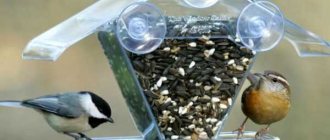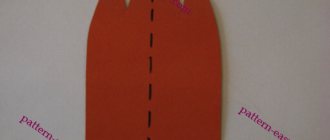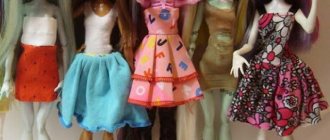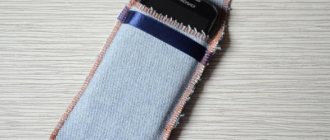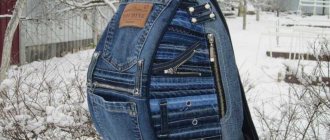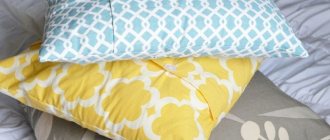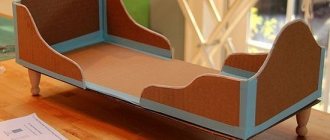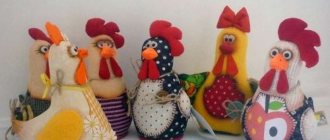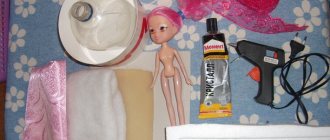How to sew an apple from fabric
I haven’t shown fabric crafts for a long time, today I’ll tell you and in the master class I’ll show you the correct pattern on how to sew an apple from fabric with your own hands. The homemade product is quite complex and requires some sewing skills. You can decorate any room with it or give it to your child as a toy.
For the fabric apple we need:
— Velvet (velor), base for crafts; — Artificial velvet; — Gabardine fabric for sheet; - Scissors; — Twisted cord, approximately 7 centimeters; — Sintepon, padding polyester, holofiber, any filler; — Extended needle; - Sewing machine; — Glue gun; — Pins;
- Threads.
First you need to make the right pattern. Let's draw two such details on paper. On the edge where it says “fold”, we make a fold so that when the part is cut out, it will be mirrored.
These are the cut fabric pieces we will need.
On velvet, which is artificial, we create many deep cuts.
We make lines along the edges, on the apple itself, and also on the leaf. We don’t sew up 1 centimeter on the sheet; we put the filler through this hole.
We cut off the tip of the sheet, turn it inside out, and fill it just a little with synthetic padding.
We turn the apple blank inside out, fill it, then use a regular seam to make bastings. At the same time, retreating 1 centimeter.
Carefully pull the apple and hide the edges inside.
From the side of the stamen we thread a needle and thread, pull it out at the other end of the apple, and so on several times. Thus, this will give shape to the craft and stretch the end of the apple with a thread of resentment.
We roll the initial piece of artificial velvet into a tube and use a glue gun to attach the stamen to the apple.
We trim off the excess length.
We also glue the tail to the apple.
We also glue the leaf. For reliability, all these things can be additionally sewn.
This is the original fabric apple we managed to make.
do-crafts.ru
Textile pincushion – apple. Master class with step-by-step photos
Many of us don’t even imagine what we can give as an interesting souvenir to a woman, especially if she is also interested in needlework. Although even if we do not take this into account, we can safely create with our own hands something useful for every woman. Namely, we are talking about oven mitts for the kitchen, a case for manicure scissors or a needle case. Yes, exactly the pincushion! Let's remember the old days, I don't know about you, but I quite often saw a small pad attached to the wall near the kitchen curtains, into which a needle was inserted. And this was most likely for convenience, because very often force majeure occurs when you need to quickly get a needle and mend something. It was probably more convenient for them this way.
But we bring to your attention an interesting master class on sewing an original pincushion, which can also be used to decorate an interior in a very interesting way, but at the same time it is interesting in design and can serve as an original gift for anyone.
What do we need to sew a needle bed ?
In order to create an apple pincushion with our own hands, we will prepare: green cotton fabric, green and marsh felt, threads to match the fabric and padding polyester or other filler such as silicone or holofiber. The only thing to remember is that cotton wool is not at all suitable for such cases. Firstly, it does not maintain its appearance, and secondly, when wet, it deforms the work, which cannot be said about silicone and holofiber.
Let's draw the details of the apple and the leaf on a piece of paper, or print the finished drawing on A4 sheet format. We indicate the number of parts of the apple.
We cut out the paper patterns strictly along the contour.
Fold the green fabric in two layers, facing inward.
Pin the pattern to the fabric.
Using chalk, transfer the pattern onto the material according to the outline.
We cut out the parts with small allowances.
For the leaves, prepare green felt.
We pin the pattern with a pin. Using chalk, a pencil or a ballpoint pen, transfer the outline of the patterns onto the felt.
Cut out two leaves without allowances.
We grind the details of the needle bed along the marked lines.
Using the tips of scissors, we make notches along the seams. This way, it will be easier for us to turn the work inside out, and the work itself will be much neater when turned inside out.
Turn the product right side out.
We turn the untreated cut 1 cm inward. Pin the hem. Let's iron it.
Fill the apple part with padding polyester.
Over the edge, using hand stitches, we sew a line along the hem for assembly.
We tighten the thread to gather.
We secure the gathering with a few hand stitches.
Using a needle, we stitch the apple through and bring it out from the opposite side.
Lightly tighten the thread and make a depression at the bottom of the apple. We fasten the thread to fix this recess. So it became even more like the real thing!
Cut out a small square from brown felt and sew it in the center of the apple.
Using chalk, draw veins on the leaves.
We lay lines along the chalk lines. We tie the ends of the threads into knots and bring the threads inside. Cut off the ends of the threads.
Sew on the prepared leaves. Let's make a leg. And we also sew it in the center.
Our delicious DIY pincushion apple is ready. It will be a wonderful souvenir for a girl or woman, and a needlewoman will especially appreciate such a gift!
Be creative and delight others with your work!
Source
Fruits and berries made of fabric
Added: 02/01/2013 Author of the article: Ekaterina Vinnichek
Despite the fact that our kitchen is in restrained brown and beige tones, I wanted to generously splash brightness and freshness there. And also, I thought, it’s winter now, and in winter you always want fruit. Therefore, without thinking twice, I took out my scraps and sewed fruits and berries from them. Help yourself too:
I sewed according to the famous Tilda patterns for apples, pears and strawberries. And although there is a lot of information and master classes on this topic on the Internet, I will still talk a little about my sewing here.
I circled all the patterns on 1 A4 sheet so that I could see the size ratio:
For sewing fruit, scraps of cotton or other fabric you have are perfect. Or you can make all the fruits multi-patch by sewing several small patches and cutting out halves of them. This, alas, remains my unrealized idea.
The easiest way to cut leaves is from green felt or any other non-flowing fabric. We will also need several wooden skewers.
We sew together 2 halves of fruits and berries, with a hole on one side for turning inside out.
When cutting, we make allowances only along the seams, since according to the original patterns in the places of gathering there are already allowances:
The principle of sewing berries
Next, the principle is this: turn it inside out, stuff it, and tighten the edge:
On top of the strawberry we simply sew triple felt leaves in a few stitches:
The principle of stitching apples
For fruits, the principle is a little more complicated. After stitching the parts:
After stuffing and cinching the edges (this essentially ends the work on the strawberries, but not on the fruit):
We pierce the apple right through, bringing the needle and thread down (to the center of the seam):
And then back. At the same time, we pull the thread, thereby forming the bottom of the apple:
This is the apple I got:
I cut out leaves for apples and pears from felt, one pattern at a time:
I put a leaf in each apple and secured it with transparent glue.
And then she stuck the “petioles” inside. I cut them from wooden skewers. But “stalks” made from real twigs would look best and most natural (alas, I couldn’t get to the forest, and there’s nothing suitable in the yard):
The principle of sewing pears
With pears it’s almost the same. Only they are pulled together at the bottom, and not at the top:
For pears, I made small blanks from a petiole and a leaf:
And inserting them from above inside each, secured them with glue:
I covered the place where it was tightened with a “pippy” - a small brown felt circle:
I painted the petioles of all the fruits with brown acrylic paint:
It is assumed that all these fruits and berries will be in a large wicker basket, which I have not yet found... In the near future, there will most likely be a new addition to this colorful and inedible family!
The original of this master class can be found on the author’s website.
www.vsehobby.ru
Do-it-yourself pincushion “Mannequin”
For work we will need the following tools and materials:
Sewing a mannequin: master class
First, we make a life-size mannequin pattern and transfer it to the fabric.
Next, prepare the Chinese chopstick. To avoid the mannequin turning and sliding off the stick, in the places where the chest and hips will be located, we wrap a strip of fabric smeared with glue, as shown in the photo below.
We sew or sew by hand only the sides and darts, and make zigzag notches on the bends.
We turn the workpiece inside out, insert a Chinese stick into it and tightly stuff the part with holofiber. We turn and trim the neck so that it fits more tightly to the wooden base.
We make a small hole in the bottom clearly in the center, string a stick onto it, and sew the bottom to the main fabric part of the mannequin. We insert the stick into the pre-coated coil with glue. The mannequin is ready!
If desired, it can be decorated: wrap the stick with a bright satin ribbon, tie a small bow in the neck area. Decorate the body of the pincushion with fabric or lace.
Simple lesson
The process of making an apple from plastic bottles for beginners can be traced using the example of a master class. An unusual decoration for our life can be made from everyday things.
To make an apple, prepare the necessary materials, namely: plastic bottles (the volume of which is a liter, one and a half liters) and paint of the required colors (acrylic is best), glue, a needle, scissors, matches and a knife. Also, save yourself a little effort, take another felt-tip pen or marker.
Take a green bottle and cut out a thin ring and another rectangle. On the second part, use a marker or felt-tip pen to draw two leaves with a twig. Cut out this blank.
In order to make the leaf more realistic, take a needle and draw on the workpiece, drawing veins. Also hold the leaves over the fire so that they are not too even and smooth, but slightly curled. The cut out ring will be used as a pendant.
You can use it like this, or you can twist it into a rope and hold it over the fire for a while. Thread both the twig and the leaves into the hole of the future apple; they can be secured with a match or thread.
The next step is to begin the gluing process. Take the blanks, coat both parts with glue (PVA or moment), glue them together.
After this, check the parts to ensure they do not fall apart and then proceed to the painting process.
Use Cases
An apple made from plastic bottles with your own hands can decorate any yard, garden, cottage or even vegetable garden. There is also the option of using this fake as a box to store small things. To make the bullseye, you need to hold the bottoms of the bottles together with a strip of tape or glue, rather than inserting the bottoms into one another.
A very beautiful option for using a fake apple is an apple on an apple tree that has not yet bloomed. You can also make toys in the form of animals from plastic bottles, like a pig.
Other ideas
We also suggest looking at options for other decorations for the garden, vegetable garden, and cottage made from bottles. The first option, we suggest making a hedgehog. Prepare the plastic base itself, a marker, pine cones, and fabric. Color the top of the bottle with a black marker.
Wrap the rest of the bottle in cloth. To prevent threads from falling out, run a match or lighter along the edge of the fabric. Secure it with glue.
Glue the pine cones on top of the fabric. We also glue on the eyes and nose. Here we have such a cute hedgehog.
You can also make a vase with your own hands. To do this, cut off the top of the plastic bottle. Apply heat to the edges so they are not sharp. If you are a child, then you should ask an adult about this. Paint the entire bottle with paint of any color, in our case green. Decorate the upper part of the future vase with openwork braid.
We draw flowers on the bottle, and the middle can be decorated with beads.
The last step is to glue the bow. This is such a cute vase we got. You can use it as a gift for your mother on March 8 or her birthday.
Let's sew some apples!
Now we have a golden autumn and housewives’ shelves are bursting with jars of prepared ingredients: pickles, preserves. And I propose to extend autumn by sewing charming potholders! I really love apples, so I’ll have apple oven mitts! Potholders can be different colors, just like apples. Sew the ones you like. I’ll make red and yellow potholders!
For sewing, you will need strips of fabric of different lengths, widths from 2 to 4 cm. I have these, all sorts of different scraps left over from various sewing projects.
The good thing about these potholders is that even the smallest scraps will fit here. First you need to draw a pattern of an apple on paper. If you don’t feel like drawing, you can copy mine directly from your computer monitor.
According to the pattern, we cut out one piece from the auxiliary fabric, onto which we will sew strips of fabric. The color doesn’t really matter, but some calm, plain fabric is better. Cut this part about 1.5-2 cm larger than the pattern.
In the middle of this part we pin a small square flap measuring approximately 3*3 cm. There is no need for precision here; you can cut all the flaps by hand.
In patchwork sewing, this method of sewing is called differently: hut, well, etc. Strips of fabric are sewn in a circle to each other.
We apply a strip of the same length to this square. The width of the stripes is at your discretion.
We attach the strip and bend it. You can, if you have an ironing board and iron nearby, immediately iron the sewn patches. Or run along the bent strip with a fingernail, a small ruler, or a stick. Ideally, of course, it is better to constantly run to the iron. It will turn out much neater.
So, we turned away the sewn strip, ironed it and applied the next piece. Apply in a circular motion clockwise.
And so on, one after another, we apply and attach yellow-red stripes until we fill the entire space.
Half the work is already done!
And here is the other side of the semi-finished product coin
We attach the pattern and trim off the excess fabric.
Now let’s take the lining, the gasket and put together such a sandwich: at the bottom is the lining with the wrong side up, then the gasket (I have a layer of synthetic padding) and on top is our sewn, ironed part. We pin our delicious sandwich and stitch it a little along the seams.
Here's the inside out of what a labyrinth turned out to be!
